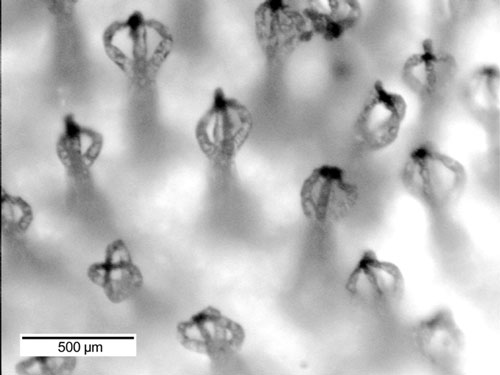| A floating weed that clogs waterways around the world has at least one redeeming feature: It's inspired a high-tech waterproof coating intended for boats and submarines. | |
| The Brazilian fern Salvinia molesta has proliferated around the Americas and Australia in part because its surface is dotted with oddly shaped hairs that trap air, reduce friction, and help the plant stay afloat. | |
| In the November 1 issue of the Journal of Colloid and Interface Science ("Nanoscale biomimetics studies of Salvinia molesta for micropattern fabrication"), Ohio State University engineers describe how they recreated the texture, which resembles a carpet of tiny eggbeater-shaped fibers. The plastic coating they created in the laboratory is soft and plush, like a microscopic shag carpet. | |
| In nature, air pockets trapped at the base of Salvinia's hairs reduce friction in the water and help the plant float, while a sticky region at the tips of the eggbeaters clings lightly to the water, providing stability. | |
| It's the combination of slippery and sticky surfaces that makes the texture so special, said Bharat Bhushan, Ohio Eminent Scholar and the Howard D. Winbigler Professor of mechanical engineering at Ohio State. | |
| "The Salvinia leaf is an amazing hybrid structure. The sides of the hairs are hydrophobic – in nature, they're covered with wax – which prevents water from touching the leaves and traps air beneath the eggbeater shape at the top. The trapped air gives the plant buoyancy," he said. | |
"But the tops of the hairs are hydrophilic. They stick to the water just a tiny bit, which keeps the plant stable on the water surface." |
| In tests, the coating performed just as the Salvinia hairs do in nature. The bases of the hairs were slippery, while the tips of the hairs were sticky. Water droplets did not penetrate between the hairs, but instead clung to the tops of the eggbeater structures – even when the coating sample was turned on its side to a 90-degree vertical. | |
| With commercial development, the coating could reduce drag and boost buoyancy and stability on boats and submarines, Bhushan said. | |
| Bhushan and master's student Jams Hunt compared the stickiness of their plastic coating to the stickiness of the natural Salvinia leaf using an atomic force microscope. The two surfaces performed nearly identically, with the plastic coating generating an adhesive force of 201 nanoNewtons (billionths of a Newton) and the leaf generating 207 nanoNewtons. | |
| That's a very tiny force compared to familiar adhesives such as transparent tape or even masking tape. But the adhesion is similar to that of another natural surface studied by Bhushan and other researchers: gecko feet. |
Fuente: |



No comments:
Post a Comment